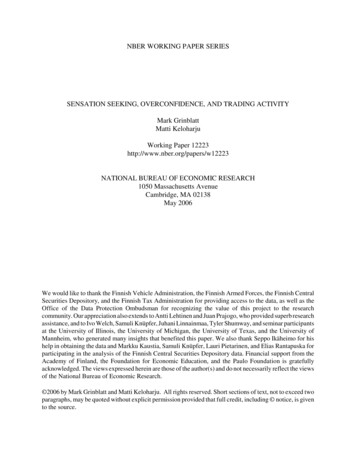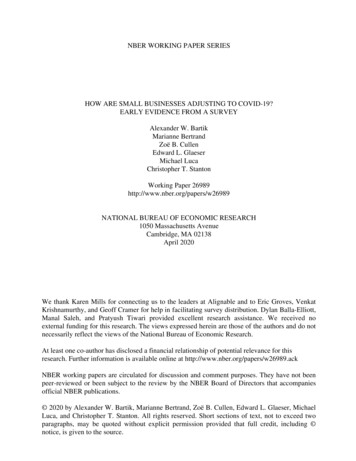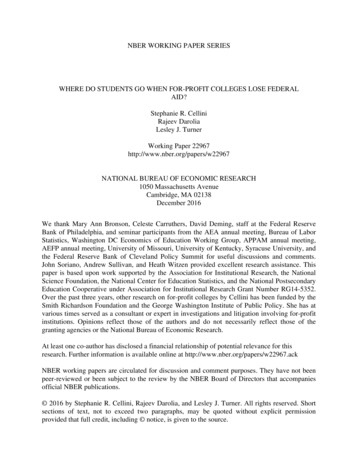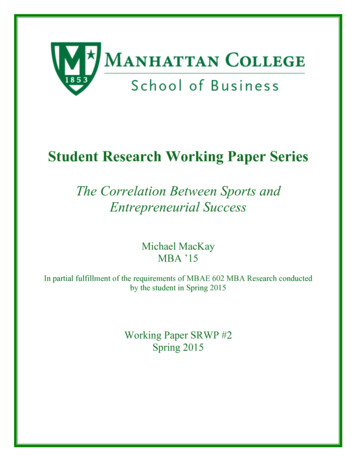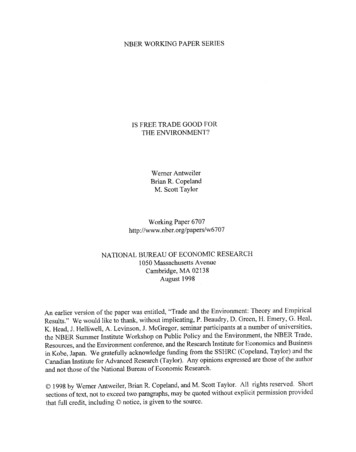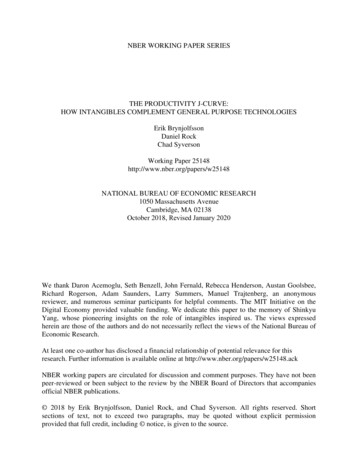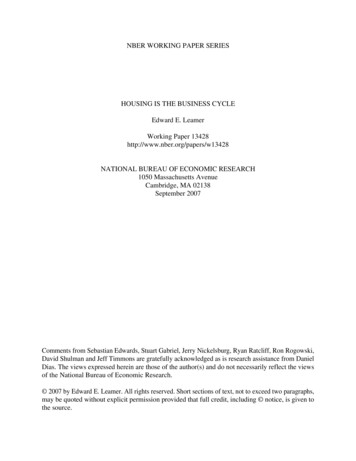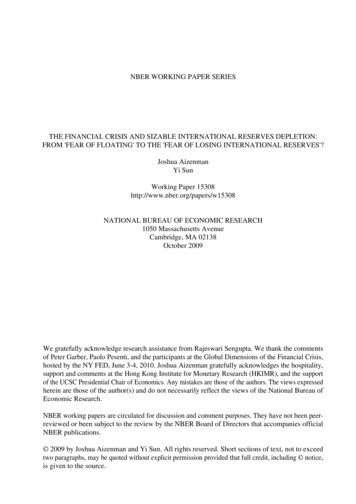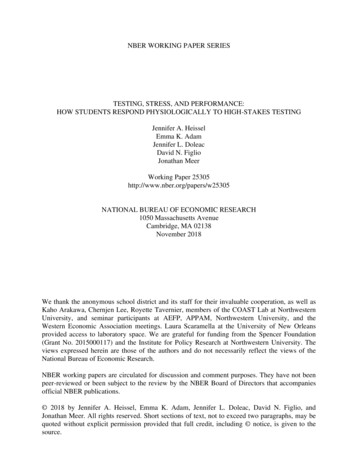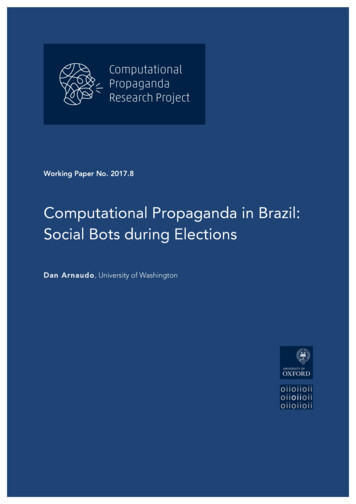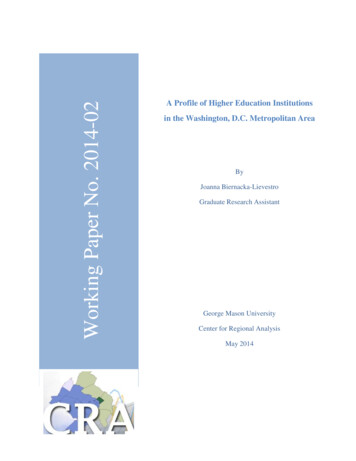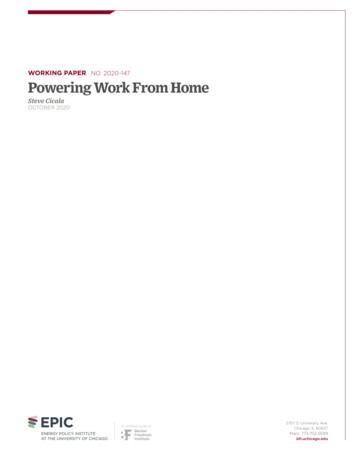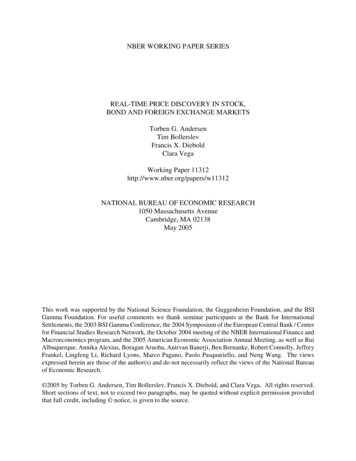
Transcription
NBER WORKING PAPER SERIESREAL-TIME PRICE DISCOVERY IN STOCK,BOND AND FOREIGN EXCHANGE MARKETSTorben G. AndersenTim BollerslevFrancis X. DieboldClara VegaWorking Paper 11312http://www.nber.org/papers/w11312NATIONAL BUREAU OF ECONOMIC RESEARCH1050 Massachusetts AvenueCambridge, MA 02138May 2005This work was supported by the National Science Foundation, the Guggenheim Foundation, and the BSIGamma Foundation. For useful comments we thank seminar participants at the Bank for InternationalSettlements, the 2003 BSI Gamma Conference, the 2004 Symposium of the European Central Bank / Centerfor Financial Studies Research Network, the October 2004 meeting of the NBER International Finance andMacroeconomics program, and the 2005 American Economic Association Annual Meeting, as well as RuiAlbuquerque, Annika Alexius, Boragan Aruoba, Anirvan Banerji, Ben Bernanke, Robert Connolly, JeffreyFrankel, Lingfeng Li, Richard Lyons, Marco Pagano, Paolo Pasquariello, and Neng Wang. The viewsexpressed herein are those of the author(s) and do not necessarily reflect the views of the National Bureauof Economic Research. 2005 by Torben G. Andersen, Tim Bollerslev, Francis X. Diebold, and Clara Vega. All rights reserved.Short sections of text, not to exceed two paragraphs, may be quoted without explicit permission providedthat full credit, including notice, is given to the source.
Real-Time Price Discovery in Stock, Bond and Foreign Exchange MarketsTorben G. Andersen, Tim Bollerslev, Francis X. Diebold, and Clara VegaNBER Working Paper No. 11312May 2005JEL No. F3, F4, G1, C5ABSTRACTWe characterize the response of U.S., German and British stock, bond and foreign exchange marketsto real-time U.S. macroeconomic news. Our analysis is based on a unique data set of high-frequencyfutures returns for each of the markets. We find that news surprises produce conditional mean jumps;hence high-frequency stock, bond and exchange rate dynamics are linked to fundamentals. Thedetails of the linkages are particularly intriguing as regards equity markets. We show that equitymarkets react differently to the same news depending on the state of the U.S. economy, with badnews having a positive impact during expansions and the traditionally-expected negative impactduring recessions. We rationalize this by temporal variation in the competing "cash flow" and"discount rate" effects for equity valuation. This finding also helps explain the apparent time-varyingcorrelation between stock and bond returns, and the relatively small equity market newsannouncement effect when averaged across expansions and recessions. Hence, while our resultsconfirm previous unconditional rankings suggesting that bond markets almost uniformly react moststrongly to macroeconomic news, followed by foreign exchange and then equity markets, importantlywhen conditioning on the state of the economy the foreign exchange and equity markets appearequally responsive. Lastly, relying on the pronounced heteroskedasticity in the new high-frequencydata, we also document important contemporaneous linkages across all markets and countries overand-above the direct news announcement effects.Torben G. AndersenKellogg School of ManagementNorthwestern University2001 Sheridan RoadEvanston, IL 60208and NBERt-andersen@kellogg.nwu.eduFrancis X. DieboldDepartment of EconomicsUniversity of Pennsylvania3718 Locust WalkPhiladelphia, PA 19104-6297and NBERfdiebold@sas.upenn.eduTim BollerslevDepartment of EconomicsDuke UniversityBox 90097Durham, NC 27708-0097and NBERboller@econ.duke.eduClara VegaDepartment of FinanceUniversity of RochesterRochester, NY 14627vega@simon.rochester.edu
1. IntroductionHow do markets arrive at prices? There is perhaps no question more central to economics. Thispaper focuses on price formation in financial markets, where the question looms especially large: How, ifat all, is news about macroeconomic fundamentals incorporated into stock prices, bond prices and foreignexchange rates?Unfortunately the process of price discovery in financial markets remains poorly understood.Traditional “efficient markets” thinking suggests that asset prices should completely and instantaneouslyreflect movements in underlying fundamentals. Conversely, several prominent authors have recentlygone so far as to assert that asset prices and fundamentals may be largely and routinely disconnected.Experiences such as the late 1990s U.S. technology-driven market bubble would seem to support thatview, yet simultaneously it seems clear that financial market participants pay a great deal of attention todata on underlying economic fundamentals. The notable difficulty of empirically mapping the linksbetween economic fundamentals and asset prices is indeed striking.The central price-discovery question has many dimensions and nuances, including but not limitedto the following. How quickly, and with what patterns, do adjustments to news occur? Doesannouncement timing matter? Are the magnitudes of effects similar for “good news” and “bad news,” or,for example, do markets react more vigorously to bad news than to good news? Quite apart from thedirect effect of news on assets prices, what is its effect on financial market volatility? Do the effects ofnews on prices and volatility vary across assets and countries, and what are the links? Are there readilyidentifiable herd behavior and/or contagion effects? Do news effects vary over the business cycle?Just as the central question of price discovery has many dimensions and nuances, so too does afull answer. In this paper we progress by characterizing the simultaneous response of foreign exchangemarkets as well as the domestic and foreign stock and bond markets to real-time U.S. macroeconomicnews. More precisely, we seek to better understand the links between asset prices and fundamentals bysimultaneously combining: (1) high-quality and ultra-high frequency asset price data across markets andcountries, which allows us to study price movements in (near) continuous time; (2) synchronized surveydata on market participants’ expectations, which allow us to infer “surprises” or “innovations” when newsis announced; and (3) advances in statistical modeling of volatility, which facilitate efficient inference.By so doing, we can probe the workings of the marketplace in new and powerful ways, focusing onepisodes where the source of price movements is well identified, leading to a high signal-to-noise ratio.We proceed as follows. In Section 2 we provide background by situating our paper in theexisting literature. In Section 3 we describe our data, and in Section 4 we present our new empirical-1-
findings. We conclude in section 5. In the Appendix we sketch a stylized multi-country monetary modelthat provides a simple theoretical benchmark and useful guidance for interpreting our empirical results.2. Background and Related LiteratureOur work speaks to three related but distinct literatures. The first examines the links betweenasset prices and macroeconomic fundamentals as embodied in news announcement effects, the secondexamines the links among domestic asset markets, and the third examines the link among variousdomestic and foreign asset markets. We set the stage by discussing selected aspects of each.Asset Prices and Macroeconomic Announcement EffectsThe literature contains many empirical studies seeking to link the effects of macroeconomicannouncements to movements in stock, bond and foreign exchange returns. While the first generationstudies relied on daily, or even weekly or monthly data, the more recent literature has moved toward theuse of more finely-sampled intraday data.1 Typically, however, each market is examined in isolation.Recent examples include Fleming and Remolona (1997, 1999), Balduzzi, Elton and Green (2001),Bollerslev, Cai and Song (2000), Green (2004), Hautsch and Hess (2002), Kuttner (2001), Li and Engle(1998) who study bond markets; Bernanke and Kuttner (2005) and Kuttner (2004), Bomfim (2003),Boyd, Jagannathan and Hu (2005), Goto and Valkanov (2002), and Flannery and Protopapadakis (2002)who study equity markets; and Andersen and Bollerslev (1998), Andersen, Bollerselev, Diebold and Vega(henceforth ABDV, 2003), Almeida, Goodhart and Payne (1998), Chaboud, Chernenko, Howorka, Iyer,Liu and Wright (2004), and Galati and Ho (2003) who study foreign exchange markets.2Most theories predict an unambiguous link between macroeconomic fundamentals and the bondmarket, with unexpected increases in real activity and inflation raising bond yields (lowering prices).1The first generation of exchange rate “news” studies focused primarily on money supply announcements. Forexample, Engel and Frankel (1984), Cornell (1983), Frankel and Hardouvelis (1985) and Tandon and Urich (1987)all associate positive U.S. money surprises with appreciations of the dollar and increases in nominal interest rates.Also, Ito and Roley (1987) find that across a set of U.S. and Japanese macroeconomic announcements, U.S. moneyannouncements have the greatest impact. For a fine survey of this literature, see Frankel and Rose (1995).Similarly, the first generation of bond market “news” studies was primarily concerned with money supplyannouncements; e.g., Grossman (1981), Urich and Wachtel (1981), and Roley and Walsh (1985). The firstgeneration of equity market “news” studies, as exemplified by Schwert (1981), Pearce and Roley (1985),Hardouvelis (1987), and Cutler, Poterba and Summers (1989), also report that with the possible exception of moneysupply figures, macroeconomic news announcements generally do not affect stock prices.2Two recent notable exceptions to this single market approach are Fair (2003) who examines the joint movementsin stock, bond and foreign exchange markets around big market moves, typically associated with macroeconomicannouncements, and Faust, Rogers, Wang and Wright (2003) who estimate the response of different maturity interestrates, exchange rates, and deviations from uncovered interest rate parity (UIP) to macroeconomic news.-2-
This is also in line with the stylized model sketched in the Appendix. Empirical analyses generallyconfirm the theoretical predictions. For example, Balduzzi, Elton and Green (2001) using 1990s data findthat both positive real shocks and positive inflation shocks affect bond prices negatively and, moreover,that the absolute size of news effects generally increases with the maturity of the instrument.The nature of the link between macroeconomic fundamentals and the stock market is less clear.Stock prices depend on expected cash flows, the discount rate, and the risk premium. Holding the riskpremium constant, a positive macroeconomic shock increases expected cash flows, which increases thestock price, ceteris paribus, but it also increases the discount rate, which decreases the stock price, ceterisparibus, so the end result depends on which effect dominates.3 Again, these separate channels are readilyidentified within the stylized model in the Appendix.Theory concerning news effects on foreign exchange markets generally predicts that gooddomestic news (e.g., brisk real activity, low inflation) strengthens the domestic currency, although anexpected deterioration in the future terms of trade could have an opposing effect. As discussed forexample in ABDV (2003), most existing empirical studies support this good news hypothesis, subject tosubtleties such as announcement timing, sign effects and/or asymmetries.Within-Country Asset Markets LinksAn extensive empirical literature has explored the relationship between stock and bond returns,but little consensus has emerged. For example, using a dynamic present value model and a long sampleof annual U.S. data, Shiller and Beltratti (1992) report a strong positive correlation between stock andlong-term bond prices, while Campbell and Ammer (1993) on employing a similar variancedecomposition framework document a relatively low average correlation with a shorter and more recentsample of monthly stock and bond returns.While these and many other related studies implicitly assume constancy of the covariancestructures, much of the subsequent literature seeks to relax that constraint.4 Barsky (1989) showstheoretically, for example, that stock and bond comovement is in general state-dependent. This idea issupported by further theoretical arguments and related empirical evidence in Connolly, Stivers and Sun(2005), David and Veronesi (2004), Fleming, Kirby and Ostdiek (1998), Guidolin and Timmermann(2004, 2005), Li (2002), Ribeiro and Veronesi (2002), Rigobon and Sack (2003b, 2004), and Scruggs and3See also the recent paper by Bernanke and Kuttner (2005), which decomposes the movements in daily andmonthly equity prices around the times of FOMC meetings into a cash flow and a discount rate effect.4Many of the recent developments in the burgeoning ARCH/GARCH literature have been explicitly concerned withmodeling temporal dependencies in the correlations of asset returns; see, e.g., the discussion in Engle (2002).-3-
Glabadanidis (2003), among others.Perhaps most directly related to the empirical results presented below is the recent work of Boyd,Jagannathan and Hu (2005) who argue for a time-varying stock-market effect of the employment report,with surprise increases in unemployment serving as “good news” during expansions and “bad news”during recessions. As previously noted, one explanation, which we subsequently discuss in detail, is thatthe cash flow effect dominates during contractions, while the discount rate effect is more important duringexpansions, thus resulting in positively correlated stock and bond price changes in expansions and lower,perhaps even negative, correlations during recessions.5 There are a couple of noteworthy precedents inthe literature. In particular, Orphanides (1992) finds that the stock price response to employment newsdepends on the average unemployment rate during the previous year, hinting that the stock
Real-Time Price Discovery in Stock, Bond and Foreign Exchange Markets Torben G. Andersen, Tim Bollerslev, Francis X. Diebold, and Clara Vega NBER Working Paper No. 11312 May 2005 JEL No. F3, F4, G1, C5 ABSTRACT We characterize the response of U.S., German and British stock, bond and foreign exchange markets to real-time U.S. macroeconomic news. Our analysis is based on a unique
